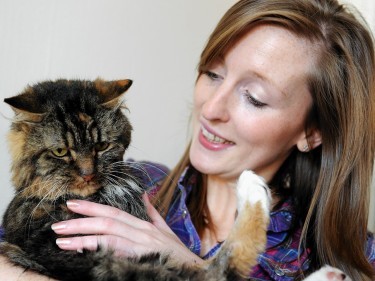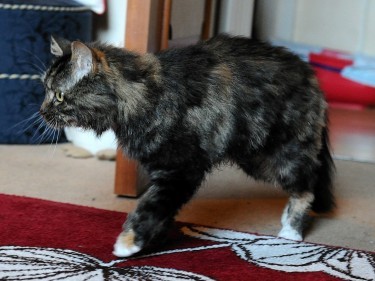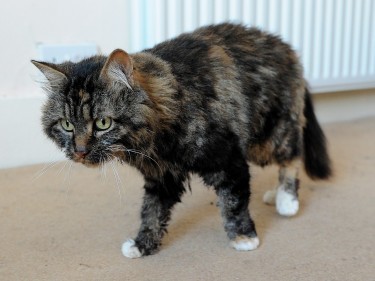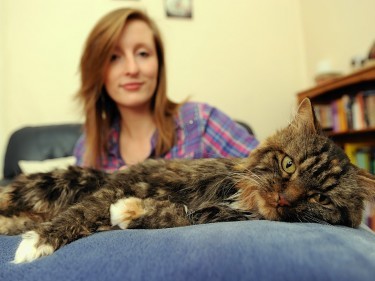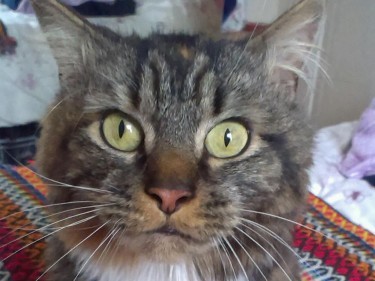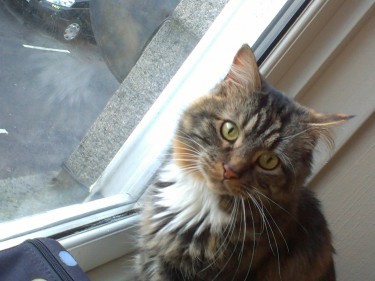Poppy the cat tottered jerkily through her Aberdeen flat as the P&J photographer and I lay in wait to capture her on camera.
Unfazed by the pair of us lying on the floor with lenses pointed in her direction, the nine-year-old slowly and awkwardly ambled past us, blankly and silently heeding the beckoning calls of her owner in the next room.
You don’t have to be a cat lover to see there’s something different about Poppy.
Cats are known for their fluidity, grace and poise, but sadly the nine-year-old tortoiseshell moggy has none of these traits.
She’s completely mechanical in her movements: her legs, particularly her rear two, barely bend; her tail sticks out from the base of her spine and hangs lifelessly behind her; and her eyes are glazed over, as if fixated perpetually on something in the middle distance.
If you didn’t hear her purr when being petted, you might think Poppy was a life-size toy.
Which, as it happens isn’t a bad description, considering she suffers from the bizarrely – though just as evocatively – titled disease, Robotic Cat Syndrome.
If you live in the north-east of Scotland, you might have heard of the neurological disease, but only because it is the sole place in the world it has been found.
The name was coined in early 2012 when a research paper was published in the Journal of Feline Medicine and Surgery, analysing the cases of 21 north-east cats which were found to have the same mysterious symptoms that reduced them to mechanical-like creatures in a matter of months.
The global media picked up the bizarre story and flew with it. What was causing this syndrome? Is it treatable? Why is it only found in the north-east of Scotland?
But with answers scant on the ground, everything soon went silent, and the robotic syndrome was all but forgotten. But then came Poppy, whose symptoms beg the question: how many other cases of robotic cat syndrome are out there in the north-east that we don’t know of?
Less than a year ago, Poppy was as lithe as any cat. Granted, she was deemed by her vet to be a little more ‘chilled out’ than regular cats, but that was initially put down as either a natural personality trait, or perhaps the result of sustaining a head injury in her youth.
“She was just a normal cat,” explained Poppy’s owner, Sarah Grieve, who adopted her two years ago.
“She could jump up on the bed, meow, scratch the sofa – all the normal cat things.And she was litter trained as well.”
However today, 10 months after first showing signs of the strange syndrome, Poppy is fairly locked in place by it. What first expressed itself in February as difficulty in self-grooming, had progressed by August to the jerky movements she now makes.
And whereas once highly vocal, she barely meows anymore. “She started slavering too, and she was never a slavery cat. She started missing the litter tray too, and you could see that she had been trying to do it properly,” Sarah, 27, said.
“Meanwhile, she was less steady on her feet, and more stiff in her movements, especially her back legs. If you went to pet her, she would flop over on her side because she couldn’t deal with the additional weight of being petted.”
By then her vet, Emily Robson – at the time working at Ashgrove Vets in Aberdeen – suggested £400 worth of tests. All came back negative for diseases which might cause similar symptoms, such as Feline Infectious Peritonitis (FIP), osteoarthritis, or toxoplasmosis.
But diagnosis was just round the corner.
Conversations between Emily and her colleagues, and also neurology experts at a lecture in the central belt soon led her to the most likely cause: Robotic Cat Syndrome – the extremely rare disease which to this day, has only been observed in the north-east.
When Emily announced the disease’s name to Sarah and her partner, Kristopher Shearer, the couple were dumbfounded.
“To be honest we laughed a bit because it’s a funny name. But it’s exactly what she’s like – a little robot,” Sarah said. Then came the bad news.
As yet, there is no successful treatment to cure, or even slow, the disease.
From the onset of symptoms, cats live for an average of 11 months until euthanasia is the only option. That’s because researchers, as hard as they may seek, can’t locate the cause. “So it was nice to know what was wrong with her, but then we immediately knew she wasn’t going to be around forever now. And, I know it sounds odd, but since we’ve been told, Poppy has gone downhill so quickly.”
As distressing as it can be to watch Poppy go about her day, she is actually a happy cat. She eats well, loves a cuddle and, while no doubt slightly uncomfortable, her condition doesn’t seem to cause much pain.
“It’s very difficult to quantify pain in cats because they don’t express it as we do,” explained Emily Robson, as we spoke in the reception area of Bridge Vets in Portlethen where she has recently moved.
“Pain in cats is shown in them being less active and interactive; less interested in owners and perhaps resenting help with grooming certain areas.”
A good way to gauge it, she explained, is to prescribe a short burst of pain medication – such as an anti-inflammatory – and if any changes in the cat’s demeanour are observed, then it could indicate the presence of pain normally.
But, as with all robotic cats, no change was seen in Poppy, meaning it’s highly unlikely the syndrome is a painful condition. When she was finally able to place her finger on Poppy’s disease, Emily, like Sarah and Kristopher, had mixed feelings.
By September, the vet had been able to get hold of the 2012 academic study, titled in its full medical terminology, ‘Slowly progressive lymphohistiocytic meningoencephalomyelitis in 21 adult cats presenting with peculiar neurological signs’.
It was fascinating to Emily to have discovered a new case of the disease, but as she read through the paper, it became clear that there was going to be little more she could do.
“It’s really interesting to get these unusual cases, but I felt a little sad actually, because I realised that, although we had a likely diagnosis, I couldn’t do anything to help Poppy,” she said.
“Really, other than giving Sarah the information that I had, and explaining the likely prognosis about the further degeneration, it was quite depressing – that this was going to affect Poppy’s life so much that, probably Sarah will have to make a decision to let her go at some point, which is sad.”
So what is the current understanding of Robotic Cat Syndrome?
The research describes it as a slowly progressive neurological disease with a group of symptoms which set it apart from other diseases of its ilk.
All diagnosed cases so far have been of cats which had access to rural areas of land, localised to the stretch of the north-east between Aberdeen and Inverness.
The 2012 study, for example, looked at cases from Huntly and Alford between 2001 and 2010.
While Poppy, an indoor cat, may seem to challenge that trend, upon contacting her previous owner, Sarah discovered that she had lived for a time in Turriff and Fyvie – areas where the disease has also popped up. And, at nine years old, Poppy also matches the average age of onset of symptoms.
A raft of potential causes have been ruled out, leaving a few suspected, but not yet pinpointed, agents.
While environmental causes such as pesticides and poisonous plant life are possible causes, the prime suspect lies in the prey-predator cycle.
In particular, it’s thought the cats are contracting a virus from their prey, such as rodents.
Beyond that, the researchers can’t be more certain at present. “There’s not very much left to be looked at,” said Luisa De Risio, first author of the academic study.
As head of neurology at the Animal Health Trust, she has been studying the strange north-east Scotland phenomenon for more than a decade.
“Perhaps, as more infectious conditions get known in mole or mice populations we could be looking at those agents if we had enough samples or money.
But it may be ‘Mission Impossible’. We can test blood and tissue from affected cats and compare to known conditions but unfortunately nothing has come out as positive.”
As to how prevalent Robotic Cat Syndrome is in the north-east, it’s difficult to know, but there don’t seem to be any signs of an increase in the “case load”, Luisa explained.
She noted that in the years since her study, there have only been a few cases reported to her each year.
And of those, only a few have been fully diagnosed, which can only be done by postmortem examination.
A handful of similar cases have cropped up in north Wales recently, but there isn’t enough evidence to suggest it’s the same disease, meaning this is still considered unique to the north-east.
In all geographical locations, Luisa added, misdiagnosis by local vets might be a problem, as the symptoms are similar to conditions like osteoarthritis in old cats.
From Emily Robson’s perspective, however, it’s unlikely that robotic cat cases aren’t being reported to local vets as “owners will recognise this behaviour as being abnormal”.
As things stand, Sarah and Kristopher are purely focused on giving Poppy the best time of what she has left, however long that may be.
“It’s like caring for someone with dementia,” Sarah explained of the extra care Poppy needs, which includes weekly baths, and cleaning after meals.
She’s already outliving other cats with the disease, but knowing when to let go is tricky.
When I interviewed them, Emily and Luisa told me that, as long as a cat is eating, drinking, moving a bit, and enjoying their cuddles, then it’s unlikely there’s a quality of life issue there.
That’s the best advice Poppy’s owners have to go on for dealing with what continues to be a very rare and mysterious disease.
“It’s so hard, because sometimes I think, ‘I can’t carry on with this’, but then I’ll be cuddling her and I just can’t think about putting her down,” Sarah added.
“I can see that she’s still enjoying life and getting affection, eating her food and playing a little bit too. When she goes into her hidey-hole under the bed and doesn’t want to do anything else, or can’t eat easily any more, then it will be very different.”
